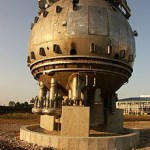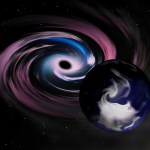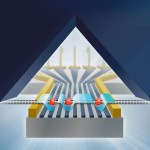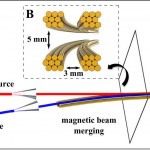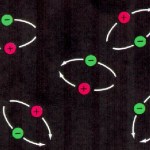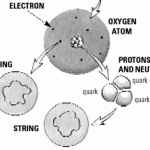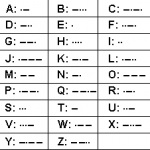Quantum mechanics
Here are some more unsung heroes of research: scanners (the human kind). In the 1950s, Donald Glaser invented the bubble chamber – a way to track infinitesimally small quantum particles as they winked in and out of existence. The idea – which may or may not have been tested in beer – was to create a large chamber of liquid under pressure next to a particle accelerator. As the beams hit their target, producing sprays of new types of short-lived particles, these energetic particles would leave tracks of bubbles in the liquid (usually hydrogen). Everything was caught on arrays of special high-…
Today's guest post is by Weizmann Institute physicist, Prof. Micha Berkooz. Berkooz, a string theorist, recently organized a conference at the Institute on "Black Holes and Quantum Information Theory." We asked him about Hawking's recent proposal, reported in Nature under the headline:"There are no black holes."
Celebrated theoretical physicist Stephen Hawking has opened a can of worms in his 1976 paper on black holes. In a recent article, he is trying to put the worms back into the can. It may prove a little trickier than expected.
Black holes are solutions of Einstein's equations of…
A recent paper by Weizmann Institute scientists suggests that we might be able to break the third law of thermodynamics. This is how that law was originally formulated in 1908 by Walther Nernst: “It is impossible for any procedure to lead to the isotherm T = 0 in a finite number of steps,” (source: Wikipedia). To elaborate, the entropy of a system approaches nil as the temperature closes in on absolute zero, so that extracting further energy becomes increasingly difficult. According to the third law, you can get very close – temperatures of less than a billionth of a degree have already been…
Of the four new articles online on our website, three happen, purely by accident, to be on physics research. The three are very different, and yet each is an illustration of the ways that basic physics research changes our world – in small and large, practical and enlightening ways. And each is situated at a different intersection between the technological and the theoretical – a technological breakthrough that resulted from a successful attempt to provide proof for a theoretical construct, new inventions based on elementary physical principles of light, and a theory substantiated through a…
Farnsworth: "There is it. The edge of the Universe!"
Fry: "Far out. So there's an infinite number of parallel Universes?"
Farnsworth: "No, just the two."
Fry: "Oh, well, I'm sure that's enough."
Bender: "I'm sick of parallel Bender lording his cowboy hat over me!" -Futurama
Our existence here in this Universe is something that we know is rare, special, beautiful, and full of wonder.
Image credit: Kelly Montgomery.
Some things happen with amazing regularity and predictability: the occurrence of days-and-nights, the tides, the seasons, the motion of the heavenly bodies, and so much more. The…
Researchers at the Weizmann Institute of Science have fostered chemical reactions at "one hundredth of a degree above absolute zero," analogous to conditions in interstellar space. By merging two parallel beams of ultra-cold atoms, scientists kept them sedated enough for quantum behavior. Chemical reactions "took place in peaks, at specific energies – a demonstration of the tunneling that occurs when quantum particles act as waves." While quantum chemistry is new, physicists have been chilling individual atoms for years—thanks in part to the work of new Nobel laureate Dave Wineland. On…
Today’s post is about some cool chemistry – very cool. About 0.01°Kelvin, as a matter of fact (that is, one hundredth of a degree above absolute zero). Physics experiments conducted at such temperatures are already old hat, but chemistry is another story, altogether. Scientists have been attempting to produce chemical reactions at ultra-low temperatures for at least 50 years; a Weizmann research team has finally achieved that goal.
Why try to get reactions to take place in these conditions, which are wholly unfavorable to the usual lab-type chemistry? The answer is that when temperatures drop…
Science magazine seemed to imply there was some grousing about the new Fundamental Physics Prizes awarded by billionaire Yuri Milner, but we in Rehovot think it’s a good thing. While one can quibble about which fields are still underfunded, we believe that any support for truly basic research -- the kind whose applications, if they exist, will be decades in the future, but which enlightens today us about the universe we live in – is most welcome.
It turns out that two (at least) of the nine winners have ties to the Weizmann Institute, and, completely by chance, we had recently written about…
In which I talk about the common complaint that we teach students physics that "isn't true," and the limits on that statement.
------------
Frequent commenter Ron sent me an email pointing to this post by David Reed on "What we “know” that t’aint so…. and insist on teaching to kids!":
he science we teach is pretty old. Mostly 19th century ideas about the world around us are taught as “facts” with little but anecdotal data to support it. We teach it via an ontology that replays the history of science, thus the newest and most powerful scientific understandings are viewed as “too advanced”. If…
This week's Weizmann news stories: A "steam release valve" for inflammation, a "brake" for cell division and an "amplifier" for quantum signals.
The steam release valve mechanism also involves an amplifier - one that ramps up the inflammation signal in response to viral attack on a cell. When the signal reaches its peak, it trips a nearby protein called caspase-8, which then kills the amps, damping the signal back down. The scientists think that failures in this mechanism could be behind various inflammatory diseases.
The brake on cell division turns out to be our old friend p53. Thirty…
On Built on Facts, Matt Springer writes that "there's really no such thing as a purely continuous monochromatic light wave" and "any pulse of light that lasts a finite amount of time will actually contain a range of frequencies." Pass this pulse of light through a medium such as glass, which "can have a different refractive index for each frequency," and some very weird things start to happen. On Life at the SETI Institute, Dr. Lori Fenton explains her study of "aeolian geomorphology - how wind shapes a planetary surface." As it does on Earth, weather makes wave patterns in the dunes of…
Temperature is a pretty weird thing if you think about it. How do you best define temperature? Let me go ahead and give you my favorite definition:
Temperature is the thing that two objects have in common when they have been in contact for a long time.
Yes, that is a good definition. Maybe now you can see why temperature is weird. Doesn't it have something to do with energy? Well, something - yes. Let me take an example. Suppose pour some hot coffee into a paper cup (I use paper because styrofoam(TM) is trademarked). Further suppose that this is super hot coffee from McDonald's. Can…
[In part I of this post](http://scienceblogs.com/dotphysics/2008/11/interaction-between-light-an…), I struggled to show that a particle in an infinite well can only exist at certain energies. If you try to put a particle with more than one energy, the probability oscillates at a frequency (E2 - E1)/h. So, what is next? Well I think I am ready to attack the photon.
According to the ultimate source of truthiness (wikipedia), [the photon is the elementary particle responsible for the electromagnetic interaction](http://en.wikipedia.org/wiki/Photon). In general, the photon is view as the…
One of the fundamental aspects of physics is the study of light and how that interacts with matter. I have been putting off this post - mainly because I am not a quantum mechanic (I am a classical mechanic). There are lots of things that could be done in this post, but I am going to try and keep it limited (and maybe come back to the interesting points later). Also, most of my posts are aimed at the intro-college level or advanced high school level. This will be a little higher. If you are in high school, there is still a lot of stuff for you here.
Let me summarize where I am going to…
There is a very techincal paper this morning by Martin Bojowald that asks the question, How Quantum Is The Big Bang? Let me break it down for you.
If you took a look at empty space and zoomed in on it, looking at spaces so small that they made a proton look like a basketball, you'd find that space wasn't so empty after all, but was filled with stuff like this:
What are these? They're little pairs of matter particles and anti-matter particles. They spontaneously get created, live for a brief fraction of a second, and then run into each other and disappear. That's what happens on very small…
Over the past few months, I have been asked a number of questions about String Theory and the Universe, including from readers Benhead and Mastery Mistery. But now Jamie, whom I'm going to marry later this year, has been asking me about it, and so it's time to write something about the scientific topic of String Theory. (Send in your questions now, because I'll answer them all this week if there's enough interest.) Let's start with this pair of questions:
String theory has been around for over 20 years, and so far, there is not one shred of experimental or observational evidence in support of…
To follow up on the faster than light post here, let's ask another question:
If you can make a way of transferring information that doesn't involve matter, is that information limited by the speed of light?
First off, let's go over what information is, and then we'll talk about how transferring information without matter is even possible. Information is anything that's organized in a meaningful manner. Take a look at the following three sentences:
This sentence contains some information.
Tihs scnnteee cainntos smoe imnfriatoon.
Not a imfro nimsoe mnoisn ctrnsnet sihto.
Each of the three…
(I know I'm not doing this any more, but I couldn't resist.)
An article in New Scientist reports on musing by two reasonable and respected cosmologists— indeed, ones whom I've met myself— that our discovery of dark energy may have shortened the life of the Universe.
To which I can only say "foo". And I say "foo" on two levels. Primarily, on the sensational way in which this is described by New Scientist. But secondarily, on the interpretations of quantum mechanics that respectable cosmologists are promoting.
First of all, for a bit of perspective. The actual research paper on which this…
